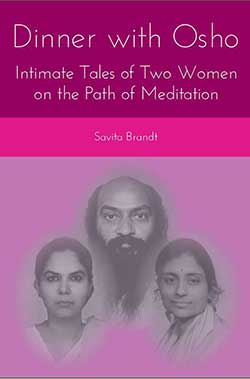Dinner with Osho

Roshani reviews Savita’s recently published book: “If you wish to partake in the intimacy with Osho afforded to early Indian sannyasins, this is the book for you.”
Dinner with Osho: Intimate Tales of Two Women on the Path of Meditation by Savita Brandt consists of detailed remembrances of the intimacies shared between two early Indian sannyasin women and Osho. For Urmila the deep initial connection was mind-to-mind. For Shobhana the connection was heart-to-heart.
Urmila is an intellectual with spiritual thirst when she first meets Osho at Jabalpur University in the Sixties. She fancies herself as a very practical, down-to-earth woman. She is bored by married life to an army man and was attracted by one of Osho’s books. She has many questions. When Urmila and Osho first meet she becomes both mind-struck and love-struck; infatuated, as well as intellectually engaged. They have many, many one-on-one conversations about both mundane and spiritual topics. Through these discussions and her new meditation practice, Urmila begins to drop from her head into her heart.
Osho awakens her sensitivity and sense of beauty, even as she completes her PhD. After about her fifth visit with Osho, she begins to note down everything he says. He speaks to her of projection, how resistance creates suffering, the need for couples to respect each other’s individuality and the need to create a less sex-conscious India, questions the Gandhian way of tradition and poverty, and encourages vegetarianism as an aesthetic matter. Osho asks her to publish these conversations in a book under her name, which she does.
She often has him to dinner or visits his home. The degree of intimacy which she has with Osho is unimaginable today. Over time Urmila’s infatuation becomes deep devotion to Osho as a spiritual guide. She learns the art of witnessing, as many more people arrive in Osho’s presence and she can no longer have the intimate personal access she once was afforded. At the end of the first section of this book, Urmila relates three esoteric stories about Osho’s relations with others.
As a youngster Shobhana was raised by uncles, barely knew her mother, and had bad experiences with sadhus and at boarding school. She is married to a doctor, sexually naïve, badly mistreated by her mother-in-law and clearly unloved. The death of her grandmother causes Shobhana to start to ask the “big” questions and an uncle takes her to an Osho lecture. Osho invites her to visit his Bombay residence, where she gets a jolt of energy as he runs his fingers up her spine. He asks her to write to him. After a while she does and poetic words just fly out of her.
Thus begins a long period of poetic correspondence with Osho. He invites her to a meditation camp, where Shobhana places her head in his lap and he strokes her like a child. She is filled with desire, love and longing for him. She takes to meeting him briefly at Dadar station as he travels to and from speaking engagements. She sells all her gold wedding jewelry to be able to afford to go to his meditation camps. She and Osho share a bedroom a time or two; occasions when there is no overt sex, but a loving intimacy.
Slowly, slowly, Shobhana feels loved and can drop her victim identity. Her relationship with Osho transforms into a playful one, then to mothering caretaker, after that to asking discourse questions, and on to the “gradual separation process that must inevitably happen between a master and his close disciple.” She assumes Osho will always be there for her, but at one point he tells her to “stand on her own feet.” She begins Vipassana meditation in earnest. In spite of many more difficult family situations, she begins to write poetry again and eventually becomes a teacher of meditation; something Osho had asked her to do years before. Shobhana’ s story seems to be the very embodiment of Osho’s book title From Sex to Superconsciousness.
Savita does a wonderful job of telling the stories of these two sexually repressed women who transcend to become true devotees. She conveys the sense of the many locations in India where those stories take place. She reveals translations of Osho’s talks never before printed in English and has taken great pains to make sure that the Hindi to English translations of both of these tales is precise and accurate. Savita also has added a Chronology at the end of the book which is one of the most detailed I have ever seen.
If you hunger for a sense of what Osho’s early days were like, this is a book for you. If you wish to partake in the intimacy with Osho afforded to early Indian sannyasins, this is the book for you. Thank you, Savita, for bringing these women’s stories to us.
Review by Roshani Shay
Dinner with Osho:
Intimate Tales of Two Women on the Path of Meditation
by Savita Brandt
Available from dancingbuddhas.in – OshoViha
Published in Pune, India by Dancing Buddhas Books, 2019
Read an excerpt
Flight of Fancy
Related articles
Savita launches her new book – ‘Dinner with Osho’ was launched on Thursday, January 18, at a celebration in the Yogi Tree Restaurant, in Koregaon Park, near the Osho Meditation Resort, writes Subhuti
Encounters with an Inexplicable Man – Roshani reviews Savita’s compilation of ‘Stories of Osho as Told by his People’
'DINNER WITH OSHO'MA YOGA SHOBHANAOSHOSAVITAURMILA
PREV POST
Flight of Fancy
NEXT POST
The matter of seat belts
RELATED POSTS
Someday you will see those peaks
Chuang Tzu dreams he is a butterfly
- Log in to post comments
- 34 views
